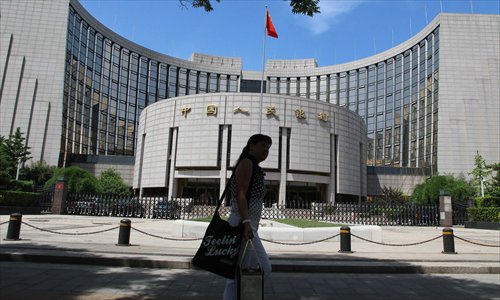HOME >> BUSINESS
Further cuts to RRR expected
By Xie Jun Source:Global Times Published: 2019/9/8 22:53:39
Support needed for economy: experts

A passenger walks past PBC's headquarters in Beijing on May 16. Photo: CFP
China is likely to launch more reserve requirement ratio (RRR) cuts this year following the one launched on Friday to lift the economy, which is under dual pressure from the trade war and domestic economic adjustments, experts say, but interest rate cuts are unlikely.
One expert also anticipated that the Friday RRR cut would cause A-shares to edge up slightly on Monday.
"Based on past experience, RRR cuts usually lead to a short-term rise in the mainland stock markets, particularly banking shares. This time, a share rise is also to be expected but because many people have already anticipated the RRR cut, the impact will be limited," Dong Dengxin, director of the Financial Securities Institute at the Wuhan University of Science and Technology, said on Sunday.
The benchmark Shanghai Composite Index edged up by 0.46 percent to 2,999.6 points on Friday, while the Shenzhen Component Index rose by 0.41 percent to 9,823.42 points.
The People's Bank of China (PBC), China's central bank, announced the cut in the RRR, the amount of cash banks are required to hold in reserve, for financial institutions by 50 basis points from September 16.
An additional 100 basis point reduction in the RRR for city commercial banks operating only in provincial administrative areas will be implemented in two phases, in October and November, cutting 50 basis points in each phase.
The move will release long-term funds of about 900 billion yuan ($127.44 billion) in total, including 100 billion yuan due to targeted RRR cuts, a PBC representative said in a statement published by the PBC on its official website on Friday.
Cong Yi, a professor at the Tianjin University of Finance and Economics, described the 900 billion yuan capital release as a "moderate stimulus." But he pointed out that compared with the past, the effects of the RRR cuts on the domestic economy will be more evident.
"In the past, liquidity release moves often resulted in incremental capital flows to the real estate sector. Now that the government has 'tightened the gate' for the real estate sector with policies like purchase restrictions, I believe new capital released by the RRR cuts will mostly benefit the real economy," he told the Global Times on Sunday.
The government has launched the RRR cuts at a time when China's economy is facing a "difficult" time, as expressed by Dong, as the economy is likely to edge down quarter by quarter this year, pressured both by trade uncertainties and difficulties faced by domestic companies in their economic transformation.
China achieved growth of 6.4 percent in the first quarter and 6.2 percent in the second quarter.
"GDP might hover around 6.0 percent in the third quarter and sink below 6 percent in the fourth quarter," Dong told the Global Times.
Considering the situation, the government has launched a package of policies including the RRR cuts and tax and expenditure cuts, as well as increasing the range of project uses for local government debt.
"Pressure is there, but China's economy has not plunged accordingly. Instead, it is showing a trend of resilience, backed by steady market demand and rising innovation," Cong said.
Dong anticipated that the government might further cut the RRR, though not in a targeted way this year. But he said that an interest rate cut is unlikely.
"First, interest rate cuts increase borrowing demand but don't release financial space for banks, which RRR cuts can. Second, the government nowadays is very cautious about adjusting interest rate standards using administrative measures," Dong said.
Posted in: ECONOMY